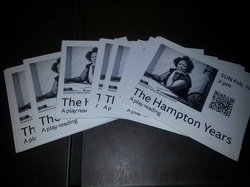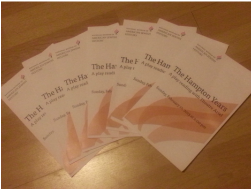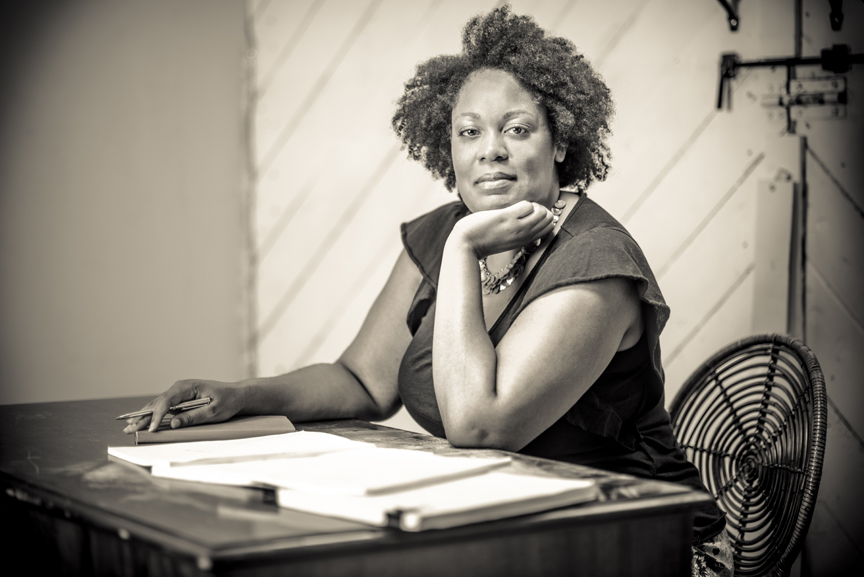 Early Sunday morning, Shirley Serotsky headed back to DC to participate in Theater J's Race In America: Where Are We Now? Presidents Day Weekend Symposium, which was presented in conjuction with their current production of David Mamet's Race. However, I was not without Theater J support and representation. The wonderfully supportive, Elaine Reuben, Theater J Council member and supporter of the Locally Grown Festival, traveled up for the occasion. We met at the Beyond Swastika and Jim Crow exhibit at the National Museum of American Jewish History and had just enough time before the reading to explore. Deborah joined us as did Rob Hargraves, Ian Lithgown, and Miriam White.  Now, as I shared in my last post, Theatre Ariel's Artistic Director, Deborah Mozes explained that learned aboutTHE HAMPTON YEARS when searching online for plays that addressed the Black and Jewish relationship. As it happens, when I was looking for research/inspiration to write a play about the Black and Jewish relationship, I stumbled across the Beyond Swastika and Jim Crow exhibit. It was here that I that learned about art professor Viktor Lowenfeld and his student John Biggers and became intrigued about what life was like for Blacks and Jewish people in the Segregated South. I searched around and found this essay entitled, Jewish Refugee Scholars at Black Colleges, by award-winning journalist, speaker, and singer, and author of Apples and Pomegranates: A Family Seder for Rosh Hashanah, Rahel Musleah, who speaks to how delicate and transforming this time period was for Blacks and Jewish people: “Sometimes the Jewish professors and their black students were made aware of the distinctiveness of their own people's experiences. For example, when Lowenfeld received a letter from the State Department detailing the tragic fate of his family, he said to his student Biggers, with whom he had forged a close relationship: 'John, you are segregated. You have to ride on the back of the bus. You can't drink water in any building. You don't have toilet facilities. But they are not burning you en masse. They are burning these members of my family and these people did not commit any crime. They were just born, that's all.' Years later, Biggers reflected on how this conversation made him understand and the extent of racial prejudice beyond his own experience: ‘I realized it went beyond black and white. I realized this was one of the truly great tragedies of the human family.’” This story really struck me and led me to dig even further. Later, I learned about artist Samella (Sanders) Lewis and that Elizabeth Catlett and Charles White were in residence at Hampton. Slowly, the play developed around these five artists, each of whom very much deserve their very own play.  Soon, it was nearing 2:00pm, so we all made our way to the theatre. My dear friend Anisa Haidary surprised me, which was so lovely. We had a nice sized audience as well. In attendance were several board members who had seen the reading the night before and even brought a few friends with them. For whatever reason, I wasn't as nervous as I was the previous night and so was able to enjoy the experience fully. The cast looked wonderful on the stage and did such an excellent job. They seemed even more embodied of their characters and in tune with the circumstances of the world of the play. The post show discussion was filled with praise for the script and a deep appreciation for the examination of these artists. The cast spoke about how the play had impacted them, which had a great deal to do with art and self-expression, with speaking/not compromising the truth and the ability of theatre to be tool of social justice, empowerment and positive change in the community. It was really wonderful. I learned so much from our rehearsal and these two readings. I am so thankful to Deborah and everyone at Theatre Ariel for bringing together such a smart, talented, funny, and passionate cast to help me tell this story. I'm excited to incorporate all that I've learned into the next draft ahead of its reading at the Phillips Collection on Saturday, April 13 at 2:00pm. More details anon. For now, here are some photos from the reading at the National Museum of American Jewish History directed by Theatre Ariel Artistic Director Deborah Baer Mozes and cast Taysha Canales, Akeem Davis, Khris Davis, Stephen Hatzai, Robert Hargraves, Ian Lithgow, Ashley B. Spearman, and Miriam White. Enjoy!
0 Comments
Your comment will be posted after it is approved.
Leave a Reply. |
My BlogI'm a playwright, dramaturg, and teaching artist. It is here where you'll find my queries and musings on life, theater and the world. My posts advocate for diversity, inclusion, and equity in the American Theatre and updates on my own work. Please enjoy!
Categories
All
Archives
June 2020
Reading List
|
